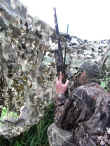


Hides
built beside a hedge blend in well and are practically invisible when
constructed properly. In order
to achieve this we have found the use of two camouflage nets in a woodland pattern, one
behind the other works best. The area inside, and to the back of the hide needs
to be cleared of nettles, thorns, obstructions, etc. which can catch in clothing
or sting / pinch, trip, etc. leading to an uncomfortable days shooting. Viewing holes ( letterboxes) can be cut in the hide
to aid viewing the pattern and surroundings. (If cutting viewing
holes in the net cut three sides of a rectangle and then fold back and
tie. The net can then be easily repaired, in the future, if viewing holes need
to be moved / closed). One is less noticeable
to incoming birds when looking through the hide rather than over it, as
movement, such as the bobbing of a head searching the skies, can attract
the birds attention. When constructing a hide
by a hedge enter the hide from the side, thereby leaving vegetation standing
undisturbed in front of the hide which adds to the camouflage and aids
concealment.
As
there are always two of us in the hide we construct a rather large hide
(approx.
4 metres long) to accommodate two shooters plus two dogs.



The
hide we use is constructed using eight adjustable poles - four at the front and
four at
the back. In windy weather it is advisable to weave the poles through the net to
stop it blowing about. Metal pegs, like those used to hold down a tent are also
useful to secure the bottom of the net. The reason for the two centre poles at the front and back is we can drape
a net across the centre of the hide to divide it in two. We can also tie a small
net onto these poles, acting as a roof in the centre of the hide, which gives good cover
over the centre of the hide plus allows a
shooting area directly overhead. This, we discovered
greatly aids concealment in a large hide, especially from crows. We found that
some crows, acting as look - outs, particularly if they have previously
been decoyed, follow the hedge when coming in to the
decoys, to 'check out' the area. If high in the sky on
approach they were at the perfect angle to see into the hide. The centre net and
partial roof avoids this dilemma no matter which side the crows approach from.



When the
hide is constructed it is important to incorporate local natural vegetation into
the netting of the hide to camouflage it and help it blend in with the immediate environment.
Clumps of dead grass, or any other vegetation which is in the immediate vicinity
of the hide, can be woven in along the top and sides of the hide to
eliminate the straight line the net forms. If
the hedge behind the hide is sparse it is important to erect a backdrop net to
avoid your silhouette being visible to incoming birds. The complete
hide must blend in with the hedge and not be obtrusive, see through or attract
attention. It should be practically invisible to incoming birds.





When
the construction is complete you should stand back from the hide casting a
critical eye over the complete set-up, adjusting and correcting areas until the
hide appears to be part of the hedge itself. The hide, when viewed from the
area where the decoy pattern will be placed should blend in with the rest of the hedge. Time spent on this exercise will pay
dividends through the day.



A new
type of hide is now available on the market. It is a fully assembled, pop - up,
fold - down hide called the 'Dog House' or the larger version, 'The Hay House'.
We have never used these so cannot comment on their practicality or
effectiveness. Although expensive (approx. €230 + p.& p.) they look
impressive and may suit some circumstances, especially the one man outfit who
has to travel some distance. I wonder if they feel somewhat claustrophobic
inside - must wait to read some reviews before considering purchasing one.
The
Dog House


The Hay House

http://www.fmtc.co.uk




